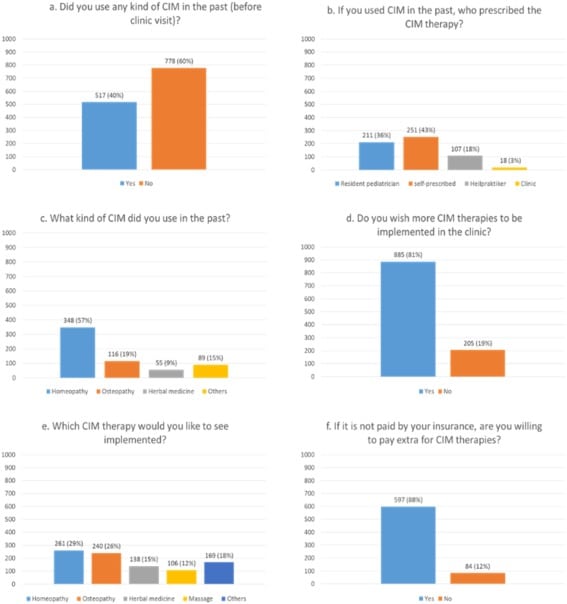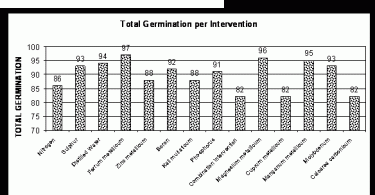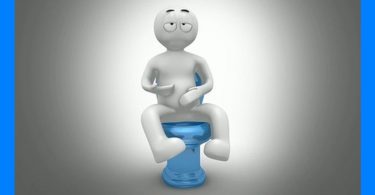Integrative Pediatrics Survey: Parents report high demand and willingness to self-pay for complementary and integrative medicine in German hospitals
Authors
Dennis Anheyer, Anna Koch, Melanie Anheyer, Catharina Amarell, Marion Eckert, Gustav Dobos, Holger Cramer
Highlights
40% of the surveyed parents stated that they already use CIM for their children at home.
More than 80% of the parents endorsed an expansion of the CIM offers at the respective hospitals.
A majority (88%) stated that they would be willing to pay extra costs if the therapy is not covered by their insurance.
Abstract
Background
In Germany, there is hardly any institutionalization of pediatric complementary and integrative medicine (CIM) present, which is one reason why the statutory health insurance companies usually do not cover the costs. Which in turn serves as an obstacle for integrating CIM into routine pediatric care. Within the present study, we assessed existing demand for CIM methods in parents of children in clinical primary care and whether the parents would be willing to cover the costs privately.
Methods
Parents who visited the Pediatric Department of the Elisabeth Hospital, Essen, Germany and the Children’s Hospital St. Marien, Landshut, Germany with their children in 2015 and 2016 were asked to take part in a paper-pencil survey. Both outpatients and inpatients were interviewed.
Results
1323 parents took part in the survey. 40 % of them stated that they already use CIM for their children. Homeopathy was the most frequently mentioned with almost 60 %, followed by osteopathy and phytotherapy. More than 80 % of the participants endorsed the expansion of the CIM offers in respective hospitals. Homeopathy was the method most desired by the parents, followed by osteopathy, phytotherapy and massage therapies. The majority (88 %) of the parents stated that they would like to take advantage of an extended range of services, including extra services that they would have to pay privately for.
Conclusion
Many parents are already using CIM for their children and are looking forward to CIM being incorporated in clinical primary care. They would also be willing to bear the costs themselves if the therapy in question is not covered by their insurance. pay for the costs themselves if the therapy is not covered by their insurance.
1. Introduction
In Germany complementary and integrative medicine (CIM) is widely used by both children and adults. In both healthy and chronically ill children, the prevalence is over fifty percent with homeopathy, phytotherapy, anthroposophic medicine, vitamins and acupuncture being the methods used most.1,2
The prevalence is steadily increasing.3 In the United States of America and Canada, complementary therapies are being increasingly integrated into routine pediatric care4; in Europe, few such programs have been established to date.
In Germany, for example, there are some anthroposophic clinics which have been offering CIM for many years. Whereas in other pediatric clinics or private practices it is uncommon.5 The main reason for this problem underlying this state of things is that CIM therapies are not the part of standard care procedures in pediatric clinics, which is related to the fact that the sufficient scientific evaluation of most CIM procedures in children is lacking.
In particular, there is still insufficient knowledge about indications, suitable protocols and dosages for many CIM therapies in children. This in turn means that they are usually not covered by the statutory health insurance either.
In this context the aim of this survey is to evaluate the existing demand for CIM methods as a supplement to conventional medicine in the sense of integrative pediatrics and whether the parents would be willing to cover the costs privately.
In order to evaluate the use, interest and wishes of patients with regards to complementary medicine offers, questionnaires were distributed in two participating hospitals (Landshut, Bayern and Essen, North Rhine-Westphalia) to parents of outpatients and inpatients in the years 2015 and 2016.
2. Methods
The study was approved by the Ethics Committee of the University of Duisburg-Essen (approval number 16-6893-BO) and conducted in accordance with the declaration of Helsinki and good clinical practice guidelines.
2.1. Study design
The present study was a paper-pencil survey. It was conducted in 2015 and 2016 at the Pediatric Department of the Elisabeth Hospital, Essen (metropolitan area of Ruhr), Germany and the Children’s Hospital St. Marien, Landshut (rural Bavaria), Germany. Both clinics are acute care hospitals and treat a wide range of diseases in general pediatric care, such as diseases of the respiratory tract and the heart, the gastrointestinal tract, the kidneys and the urinary tract, congenital metabolic diseases and diabetes mellitus in children. Both clinics did not offer CIM therapies as standard procedures before and during the time of this survey.
Data analyses took place at the Department of Internal and Integrative Medicine, Evang. Kliniken Essen-Mitte, Germany. Participants had given their written informed consent before being included in the study.
2.2. Eligibility
Parents who visited the pediatric department of the Elisabeth-Krankenhaus or the Children’s Hospital St. Marien with their children in 2015 and 2016 were asked to take part in the survey. Both outpatients and inpatients were interviewed.
2.3. Questionnaire
The survey contained nine questions related to the child’s age, parents’ educational level and insurance status, the reason for visiting the pediatric department of the hospital, whether their visit was ambulatory or stationary, prior CIM use, any desirable CIM within the clinic context, and whether parents would be willing to pay privately for additional costs. In addition, the parents had the opportunity to write down comments, wishes and suggestions.
2.4. Statistical analyses
Data were analyzed descriptively. All analyses were performed using R (version 4.0.3).
3. Results
In total, 1323 parents from the two clinics in Essen (n = 269) and Landshut (n = 1054) took part in the survey. In Essen, a total of 700 questionnaires were distributed, which means a responder rate of 38.4 %. Landshut distributed a total of 2500 questionnaires, which means a responder rate of 42.1 %. With 3200 distributed questionnaires and 1323 respondents, this survey reached a total responder rate of 41.3 %. Sociodemographic characteristics are shown in Table 1. The use of and desire for complementary and integrative medicine offers from parents are shown in Fig. 1.
Table 1. Sociodemographic characteristics.
| Empty Cell | Elisabeth Hospital (n = 269) | Children’s Hospital St. Marien (n = 1054) | Overall (N = 1323) |
| Child’s Age (Mean ± SD) | 5.8 ± 5.2 | 6.2 ± 4.7 | 6.1 ± 4.8 |
| Child’s Gender (n (%)) | |||
| Female | 106 (39.4) | 416 (39.5) | 522 (39.5) |
| Male | 148 (55.0) | 536 (50.9) | 684 (51.7) |
| Type of Clinic Visit | |||
| Outpatient | 48 (17.8) | 589 (55.9) | 637 (48.1) |
| Inpatient | 176 (65.4) | 127 (12.0) | 303 (22.9) |
| Reasons for Clinic Visit (n (%)) | |||
| Acute illness | 134 (49.9) | 512 (48.6) | 646 (48.8) |
| Chronic disease | 35 (13.0) | 59 (5.6) | 84 (6.3) |
| Frequently recurring disease | 10 (3.7) | 35 (3.3) | 45 (3.4) |
| Disease existing since birth | 16 (5.9) | 13 (1.2) | 29 (2.2) |
| Unclear disease | 55 (20.4) | 137 (13.0) | 192 (14.5) |
| CIM use in the past | |||
| Yes | 85 (31.6) | 384 (36.4) | 469 (35.4) |
| No | 171 (63.6) | 512 (48.6) | 683 (51.6) |
| Health Insurance | |||
| Statutory health insurance | 230 (85.5) | 784 (74.4) | 1014 (76.7) |
| Private health insurance | 27 (10.0) | 115 (11.0) | 142 (10.7) |
Fig. 1. Use of and desire for complementary and integrative medicine offers from parents.
4. Discussion
Forty percent of the parents surveyed stated that they already use complementary medical procedures as means of treatment for their child. The most frequently mentioned form of therapy was homeopathy with almost 60 %, followed by osteopathy and phytotherapy. More than 80 % of the parents surveyed would like to have such offers for their children at the respective hospitals. Here again, homeopathy was the method most desired by the parents, followed by osteopathy, phytotherapy and massage therapies. This high prevalence and the desire for CIM is in line with previous findings.1,3 The parents would largely be willing to pay privately for additional costs incurred.
The results of this survey show the relevance of CIM in the pediatric context and make clear demonstrate the willingness of parents to pay for such services privately if necessary. This allows to conclude that, regardless of whether health insurers cover CIM therapies, it may be worthwhile to implement CIM in children’s hospitals.
However, this should not only be considered from the financial point of view, but also in the context of providing patients with a broader range of therapies. An increased interest in CIM on the part of the clinics can in turn promote interest in research on CIM procedures in children.
This in turn will help to build up the evidence base for the procedures used, leading eventually to a virtuous circle. However, a successful implementation of CIM in a children’s clinic is not feasible without a qualified staff. In order to provide qualified training for nursing and medical staff, regulated curricula are needed, which have been lacking in Europe to date.
The interest in further training in this area on the part of medical and nursing staff is present.6 Further institutionalization of CIM could also facilitate better control of the procedures used and strengthen the use of evidence-based measures, some of which are also available in the pediatric context.7,8
This study has some limitations. Most notably, the inclusion of only two hospitals into the survey limits the generalizability of the findings. Furthermore, future studies should evaluate whether the parents would really be willing to pay for the treatment privately if it came to that.
To conclude, there is an urgent need for educated professionals with an evidence-based knowledge of the opportunities and risks of CIM and for advancing the institutionalization of CIM therapies. More rigorous research on safety and effectiveness of CIM therapies in children is needed to support the implementation of CIM into routine pediatric care. All this together can also promote a change in thinking on the part of the health insurance companies to pay for individual CIM therapies. In any case, there is a demand for CIM on the part of parents and patients and this should not be ignored.
Authors statement
Dennis Anheyer: Conceptualization, Methodology, Formal analysis, Writing – Original Draft, Visualization. Anna Koch: Methodology, Writing – Original Draft, Visualization, Writing – Review & Editing. Melanie Anheyer: Investigation, Resources, Writing – Review & Editing. Catharina Amarell: Investigation, Resources. Marion Eckert: Resources, Supervision. Gustav Dobos: Writing – Review & Editing, Supervision. Holger Cramer: Conceptualization, Methodology, Writing – Review & Editing, Project administration.
Funding sources
The study was supported by a research grant from the Karl and Veronica Carstens Foundation.
Acknowledgement
We acknowledge support by the Open Access Publication Fund of the University of Duisburg-Essen.
Appendix A. Supplementary data
The following is Supplementary data to this article:
Download : Download Word document (13KB)
Reprinted from: https://www.sciencedirect.com/science/article/pii/S0965229921000984
References
1 Gottschling, B. Gronwald, S. Schmitt, et al.
Use of complementary and alternative medicine in healthy children and children with chronic medical conditions in Germany
Complement Ther Med, 21 (Suppl 1) (2013), pp. S61-9, 10.1016/j.ctim.2011.06.002013/04//
View Record in ScopusGoogle Scholar
2 Längler, C. Spix, F. Edelhäuser, G. Kameda, P. Kaatsch, G. Seifert
Use of homeopathy in pediatric oncology in Germany
Evid Based Complement Alternat Med, 2011 (2011), Article 867151, 10.1155/2011/867151
View Record in ScopusGoogle Scholar
3 T.J. Zuzak, J. Boňková, D. Careddu, et al.
Use of complementary and alternative medicine by children in Europe: Published data and expert perspectives
Complement Ther Med, 21 (April Suppl 1) (2013), pp. S34-47, 10.1016/j.ctim.2012.01.001
4 Vohra, S. Surette, D. Mittra, L.D. Rosen, P. Gardiner, K.J. Kemper
Pediatric integrative medicine: Pediatrics’ newest subspecialty?
BMC Pediatr, 12 (1) (2012), p. 123, 10.1186/1471-2431-12-123
2012/08/15
5 Eckert, C. Amarell, D. Anheyer, H. Cramer, G. Dobos
Integrative Pediatrics: Successful Implementation of Integrative Medicine in a German Hospital Setting-Concept and Realization
Children (Basel), 5 (September 9) (2018), 10.3390/children5090122
6 Anheyer, C. Kern, G. Dobos, H. Cramer
“I think you can achieve quite a lot if all of the staff stands behind it”-A qualitative study about the experience, knowledge and application of complementary therapies and integrative medicine in pediatrics
Complement Ther Med, 41 (December) (2018), pp. 186-191, 10.1016/j.ctim.2018.09.025
7 P.M. Wopker, M. Schwermer, S. Sommer, et al.
Complementary and alternative medicine in the treatment of acute bronchitis in children: A systematic review
Complement Ther Med, 49 (March) (2020), Article 102217, 10.1016/j.ctim.2019.102217
8 Schwermer, K. Fetz, A. Längler, T. Ostermann, T.J. Zuzak
Complementary, alternative, integrative and dietary therapies for children with Crohn’s disease – A systematic review
Complement Ther Med, 52 (August) (2020), Article 102493, 10.1016/j.ctim.2020.102493





